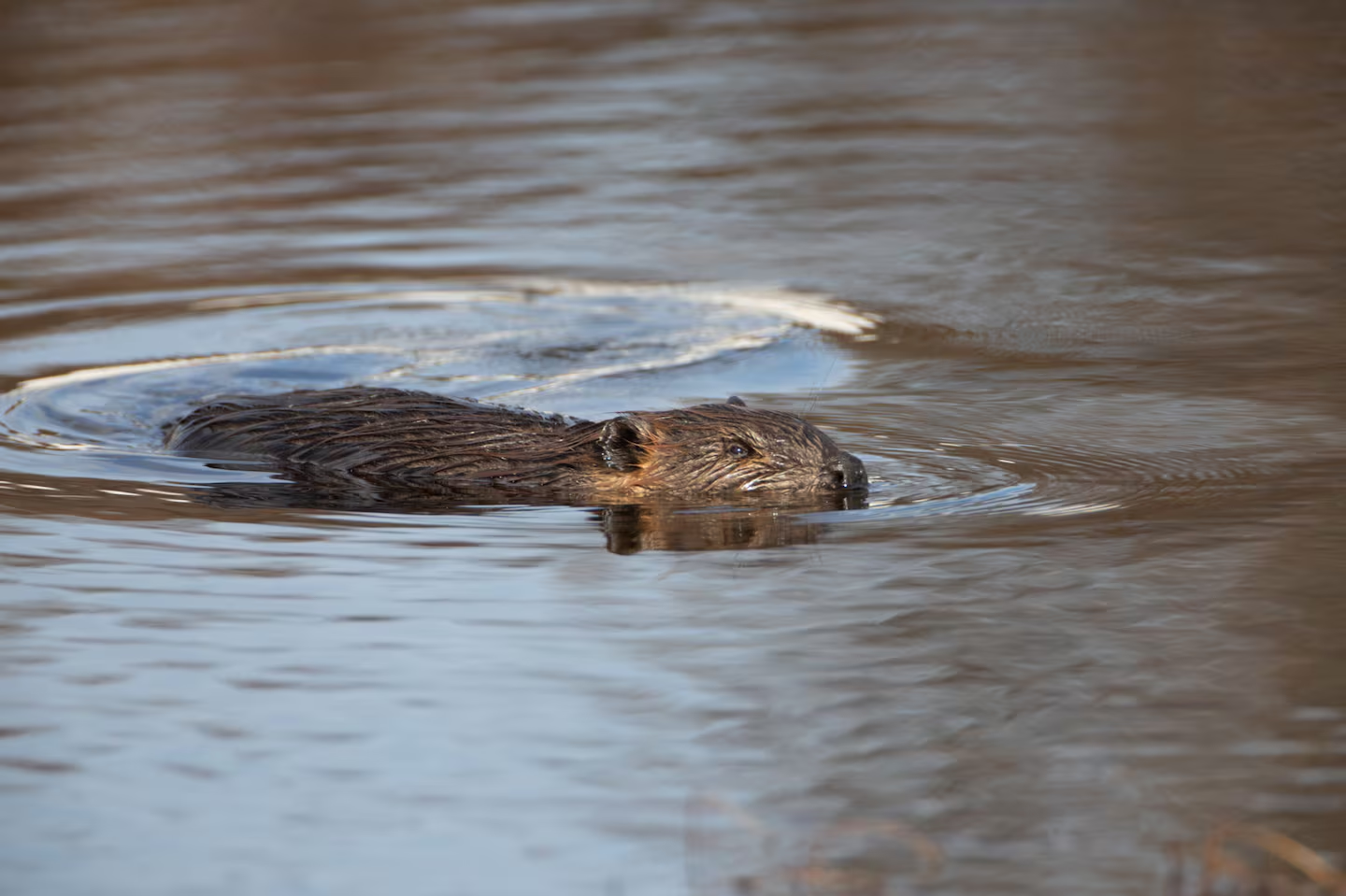
Beings and biomes: keystone and indicator species
By Madison Grosvenor
Imagine walking under the masonry arch of an old castle. As you go under the arch, look up. See that central wedge-shaped stone in the middle of the arch? That’s the “keystone.” That’s the piece that locks the rest together.
A keystone species does the same thing within an ecosystem. These plants and animals hold ecosystem balance and structure together. Without these keystone species, the ecosystem would look dramatically different or cease to exist altogether.
“Keystone species” isn’t an official classification, as scientists often debate which plants or animals in an ecosystem deserve the title. Some say calling an animal or plant a keystone species can oversimplify the role of one species in complex relationships between species and habitats. Yet, understanding what animals and plants play that vital keystone role can help us grasp how crucial one being can be to the survival of countless others—and to monitor the health of all.
Alaska’s vast landscapes depend on this delicate balance of animals and plants to stay healthy, all held in place by a keystone.
Top of the food chain
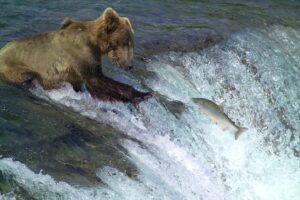
Brown bear fishing for salmon in Katmai National Park. Photo courtesy of the National Park Service.
Ecologists and researchers talk about three types of keystone species: predators, ecosystem engineers, and mutualists. Almost all keystone species have a huge influence on food webs.
Many predator animals like wolves, bears, and bobcats are considered keystone species because of their role at the top of the food chain. Alaska’s brown bears play a crucial role in the ecosystem of Alaska, for example. As incredible apex predators, they keep prey populations like moose and caribou in check. This, in turn, prevents overgrazing and maintains balance across food sources. Through their foraging habits, bears also spread plant and berry seeds in their droppings and spread marine-derived nitrogen into the forest by spreading salmon nutrients up to 500 meters from rivers, enriching trees and plants beyond the riverbank.
Similarly, sea otters help maintain ecosystem balance in the ocean by protecting kelp forests from overgrazing. They eat sea urchins, a big consumer of kelp, and help maintain kelp beds as shelter, nursing grounds, and habitat for other animals.
We’re in this together!
Sea otters and kelp also fit in as mutualist keystone species. Keystone mutualists include two or more species that engage in mutually beneficial interactions wherein a change in one species would impact the other and in fact change the entire ecosystem itself.
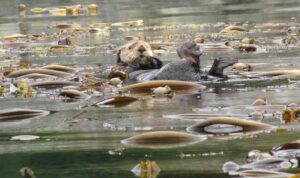
Otter floating in kelp field. Photo by Doug Smith.
Sea otters maintain the dense, productive forests of kelp in coastal Alaska. Those kelp forests in turn provide vital habitat for invertebrates, which in turn feed more than 20 species of fish. They also serve as spawning grounds for herring and Atka mackerel and nursery areas for young salmon. Many birds, including sea ducks, rely on these underwater forests for shelter and food.
Kelp forests help protect coastlines from powerful waves and, much like terrestrial forests, absorb carbon dioxide from the atmosphere, playing a role in slowing global warming.
When sea otters feast, kelp forests flourish.
Ah, the busy beaver
The third type of keystone species, ecosystem engineers, modify, create, or maintain habitats, for better or for worse.
Take beavers, who engineer wetlands by constructing dam lodges. Modification often improves the health of the habitat. By damming rivers, beavers create still water ponds that increase the amount of water in a given area by allowing water to filter into the ground, thus raising the water table, recharging aquifers, and improving water quality downstream.
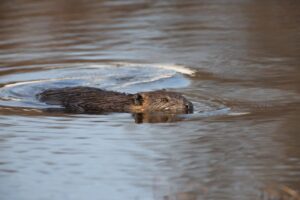
Beaver seen in Nome area. Photo courtesy of Peter Pearsall, USFWS.
But, in Alaska, beavers started moving north into tundra regions 40-50 years ago and have continued since, likely due to climate change.
In this case, the modifications are consequential, potentially speeding up climate change in an already thawing Arctic. Beaver ponds are thawing permafrost, inundating areas with water, and turning small streams into sprawling wetlands. Elsewhere, they are completely drying out habitat.
Their dams can be barriers to fish migrations, particularly of whitefish, with impacts to people who fish in the area for food and to Arctic beluga whales who rely on that whitefish.
So, a keystone species can alter existing environment in ways that inhibit the growth of native plants and animals. In other words, keystone species can have negative impacts in one place and positive impacts in another.
Indicator species— nature’s red flags
While keystone species tell us something about the structure and function of an ecosystem, indicator species tell us about the health of that ecosystem.
Also known as bioindicators, these indicator organisms show us that something has changed or is going to change in their environment.
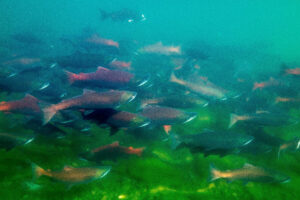
Sockeye salmon migrating in the Kenai National Wildlife Refuge. Photo by Ryan Hagerty, USFWS.
Salmon are extremely susceptible to change and can reveal information about the health of rivers, oceans, and everything in between. When water temperatures rise, salmon eggs struggle to hatch, and juveniles grow too fast or are too weak to survive. If industrial projects pollute or damage spawning streams, for instance, fewer fish return to reproduce. Or changes in temperature and acidity can disrupt the tiny plankton that fish salmon rely on for food, leading to smaller, weaker fish.
A bad salmon run isn’t just bad luck, it’s often a sign of bigger problems, whether from warming waters or destroyed habitat or shifting ocean currents.
Salmon happen to be both a keystone and an indicator species. Bears and eagles rely on their nutrients and forests grow stronger when salmon carcasses feed the soil. Salmon are central to Alaska Native communities and have been since time immemorial, and commercial and sports fisherman count on strong salmon runs too.
Tracking salmon numbers year after year helps scientists, fishers, and communities understand what’s changing in Alaska’s waters and our climate—because when salmon start disappearing, it’s a clear sign that something is wrong.
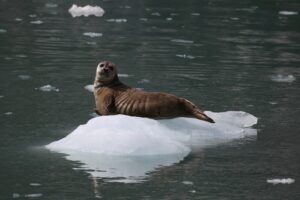
Harbor seal hauled out on ice in the Kenai Fjords. Photo by Kay White, NPS.
Several species of seal in Alaska are considered indicator species as well, like ice-dependent ringed seals and ribbon seals. They rely on stable sea ice for breeding and pupping. If their populations drop, it might signal shifts in Arctic sea ice loss due to warming temperatures.
Harbor seals are the most common seal found throughout coastal Alaska. Harbor seals are valuable indicator species for scientists monitoring ocean pollution because they accumulate toxins through their diet, reflecting the overall health of marine ecosystems. As top predators, their population trends can signal shifts in fish stocks, pollution levels, and ocean conditions. Contaminants enter ocean waters from many sources, including oil and gas rigs, toxic wastewater discharges, agricultural and urban runoff, and other industrial processes. Once in the environment, these substances move up the food chain and bioaccumulate in predators such as harbor seals.
It’s the small things
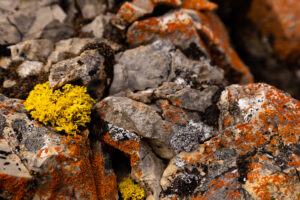
Bright yellow and orange lichens tuck among the subalpine rocks. Credit: Lisa Hupp/USFWS.
Not all indicator species are animals, or even single organisms. Lichen communities are highly sensitive to climatic conditions, making them potential harbingers for climate change. They can serve as useful indicators for detecting long-term trends in the larger ecological community, including the effects of changing air quality. Without roots, they depend entirely on the atmosphere for water and nutrients. Lacking an outer epidermal layer, they absorb both nutrients and pollutants without distinction.
Select species are highly sensitive to pollution and will decline or die even at low exposure levels, making lichen community composition a reliable measure of ecosystem health. In parks like Cape Krusenstern National Monument, lichen communities are monitored for mine-related and dust-borne heavy metals along the Red Dog Mine haul road. Studies show that the lichen species’ richness declines substantially closer to the road.
The importance of lichens health extends from Alaska’s southeast to the northern tundra floor. Lichens are often a major component of forage consumed by caribou, another significant indicator species of the Arctic.
Caribou are picky. As herbivores that rely on tundra and boreal forests for food, their health and migration patterns reflect the overall condition of these habitats. Shifts in caribou populations or changes in their migratory routes can signal disruptions caused by climate change, habitat degradation, or disturbances like oil and gas operations and drilling. By monitoring caribou populations, scientists can gain insights into the broader ecological impacts affecting Alaska’s wildlife and ecosystems.
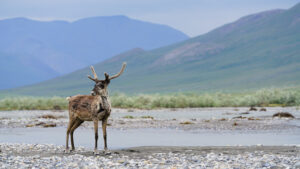
Caribou at the Hula Hula in the Arctic National Wildlife Refuge. Photo by Danielle Brigida, USFWS.
Caribou are unique, as they can be placed under the category of indicator species, keystone species, and something called an umbrella species. An umbrella species refers to an animal or plant whose health connects to vast geographic regions. In other words, if you can protect the health of an umbrella species, you also protect the health of a large number of plants and animals in that species’ range.
Caribou are widely considered a cultural keystone species, too. A cultural keystone species deeply influences not just its environment, but the cultures that have developed alongside it.
What’s in a name
Ecosystems are dynamic and interconnected, making it difficult to assign rigid labels to species whose roles may shift over time or across different landscapes. A species considered a keystone in one environment might not play the same role elsewhere, and an indicator species may respond to multiple overlapping stressors, making it hard to pinpoint a single cause of change.
A species’ influence can vary depending on time, location, and environmental conditions. Beavers enhance wetland habitats in some areas, but their expansion north is accelerating permafrost thaw and altering waterways in ways that may be detrimental.
Similarly, while caribou are often seen as an indicator of Arctic health, their populations can fluctuate due to a mix of factors, including predation, climate shifts, and human activity, making it difficult to isolate a single cause when changes occur.
Our human terms also impose a human-centric framework on nature. Classifying species as keystones or indicators can lead to prioritizing certain organisms over others based on their perceived importance rather than recognizing the broader web of relationships that sustain ecosystems.
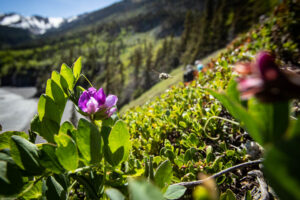
Bumblebee and sweet pea overlooking Turnagain Arm. Photo by Kesia Lee, USFS.
From an Indigenous perspective, the interconnectedness of all species is emphasized rather than ranking them in apparent hierarchies. Western science might highlight salmon as a keystone species due to their impact on forests, bears, and marine ecosystems, while Indigenous knowledge systems describe them as relatives or integral parts of a reciprocal relationship rather than what can be interpreted as ecological “tools.”
After all, terminology can have policy and management implications. Labeling a species as an indicator species may trigger an effort to protect it, but it may also lead to reactionary policies that focus on a single species rather than addressing systemic environmental issues. A declining salmon population might prompt conservation efforts aimed at salmon alone, while the root causes—rising ocean temperatures, habitat loss, or industrial pollution—require broader, more integrated solutions. Similarly, emphasizing keystone species might unintentionally downplay the roles of other, less visible species that contribute to ecosystem health in equally vital ways.
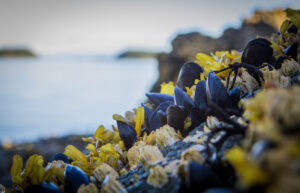
Mussels and barnacles in Katmai National Park. Photo by D Kopshever.
Take mussels and barnacles: these small creatures are vital indicator species, revealing changes in ocean acidification and water quality long before larger marine animals show the effects. Or, snowshoe hares, often overlooked in favor of their predator, the lynx, who play a role as a keystone species shaping boreal forests by influencing plant growth and providing food for a whole web of carnivores. Even tiny soil fungi quietly regulate entire ecosystems by breaking down organic matter and helping trees absorb nutrients.
These unsung heroes may not get the spotlight but without them, Alaska’s ecosystems wouldn’t function the same way, or even well.
Ecosystems are fluid, and species interact in ways that often defy assumptions and categories. Defining keystone and indicator species can help us understand those relationships within the context of a holistic approach to protecting living beings—one that values ecological complexity, integrates Indigenous knowledge, and considers the broader environmental context rather than focusing solely on individual species.
This is the third in our “Beings and biomes” series. You can find previous articles below:


